ECO mode MAZDA MODEL 3 HATCHBACK 2012 Owners Manual (in English)
[x] Cancel search | Manufacturer: MAZDA, Model Year: 2012, Model line: MODEL 3 HATCHBACK, Model: MAZDA MODEL 3 HATCHBACK 2012Pages: 525, PDF Size: 5.95 MB
Page 4 of 525
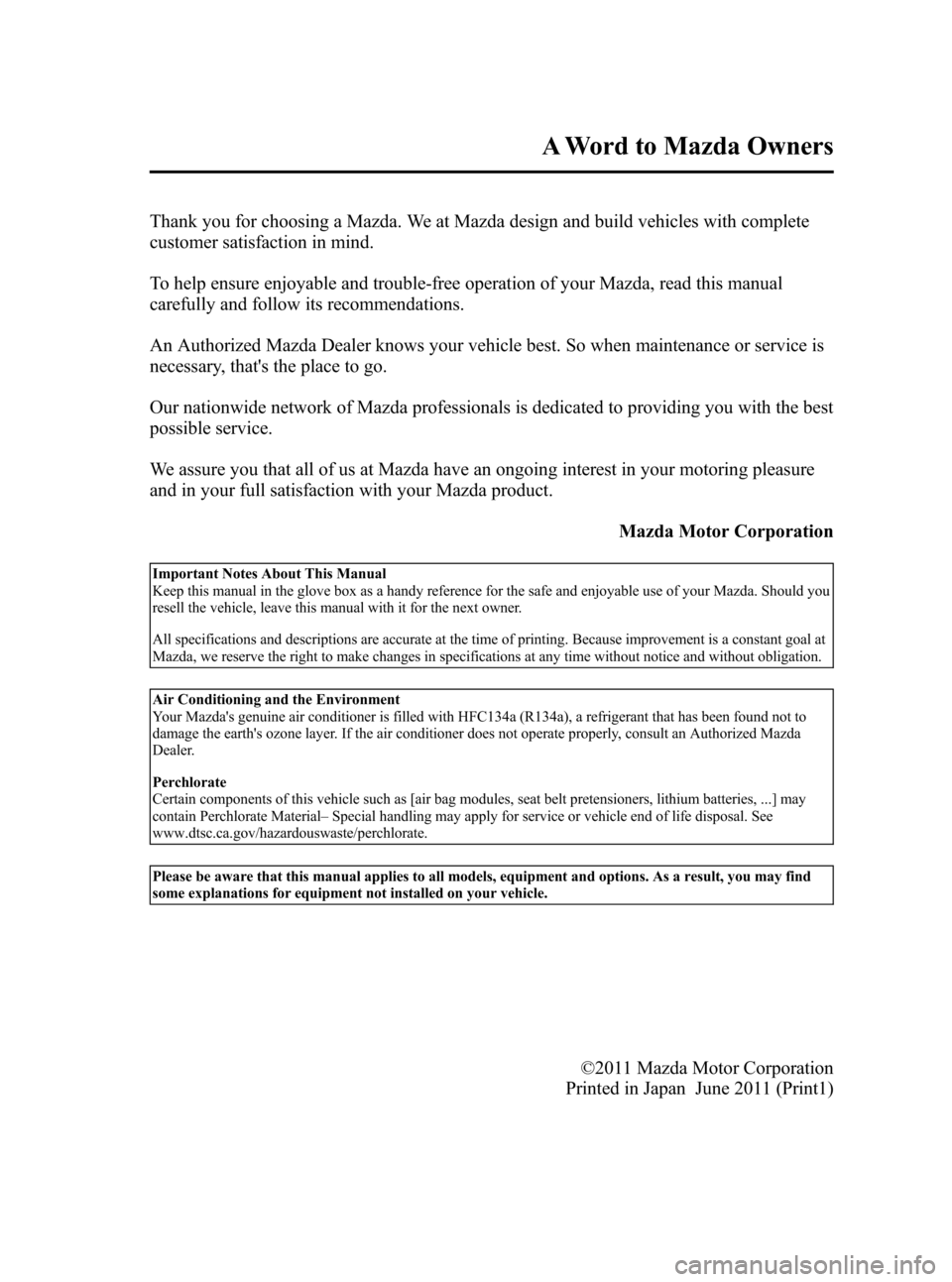
Black plate (3,1)
Thank you for choosing a Mazda. We at Mazda design and build vehicles with complete
customer satisfaction in mind.
To help ensure enjoyable and trouble-free operation of your Mazda, read this manual
carefully and follow its recommendations.
An Authorized Mazda Dealer knows your vehicle best. So when maintenance or service is
necessary, that's the place to go.
Our nationwide network of Mazda professionals is dedicated to providing you with the best
possible service.
We assure you that all of us at Mazda have an ongoing interest in your motoring pleasure
and in your full satisfaction with your Mazda product.Mazda Motor Corporation
Important Notes About This Manual
Keep this manual in the glove box as a handy reference for the safe and enjoyable use of your Mazda. Should you
resell the vehicle, leave this manual with it for the next owner.
All specifications and descriptions are accurate at the time of printing. Because improvement is a constant goal at
Mazda, we reserve the right to make changes in specifications at any time without notice and without obligation.
Air Conditioning and the Environment
Your Mazda's genuine air conditioner is filled with HFC134a (R134a), a refrigerant that has been found not to
damage the earth's ozone layer. If the air conditioner does not operate properly, consult an Authorized Mazda
Dealer.
Perchlorate
Certain components of this vehicle such as [air bag modules, seat belt pretensioners, lithium batteries, ...] may
contain Perchlorate Material–Special handling may apply for service or vehicle end of life disposal. See
www.dtsc.ca.gov/hazardouswaste/perchlorate.
Please be aware that this manual applies to all models, equipment and options. As a result, you may find
some explanations for equipment not installed on your vehicle.
©2011 Mazda Motor Corporation
Printed in Japan June 2011 (Print1)
A Word to Mazda Owners
Mazda3_8BY7-EC-11F_Edition1 Page3
Friday, June 17 2011 2:53 PM
Form No.8BY7-EC-11F
Page 27 of 525
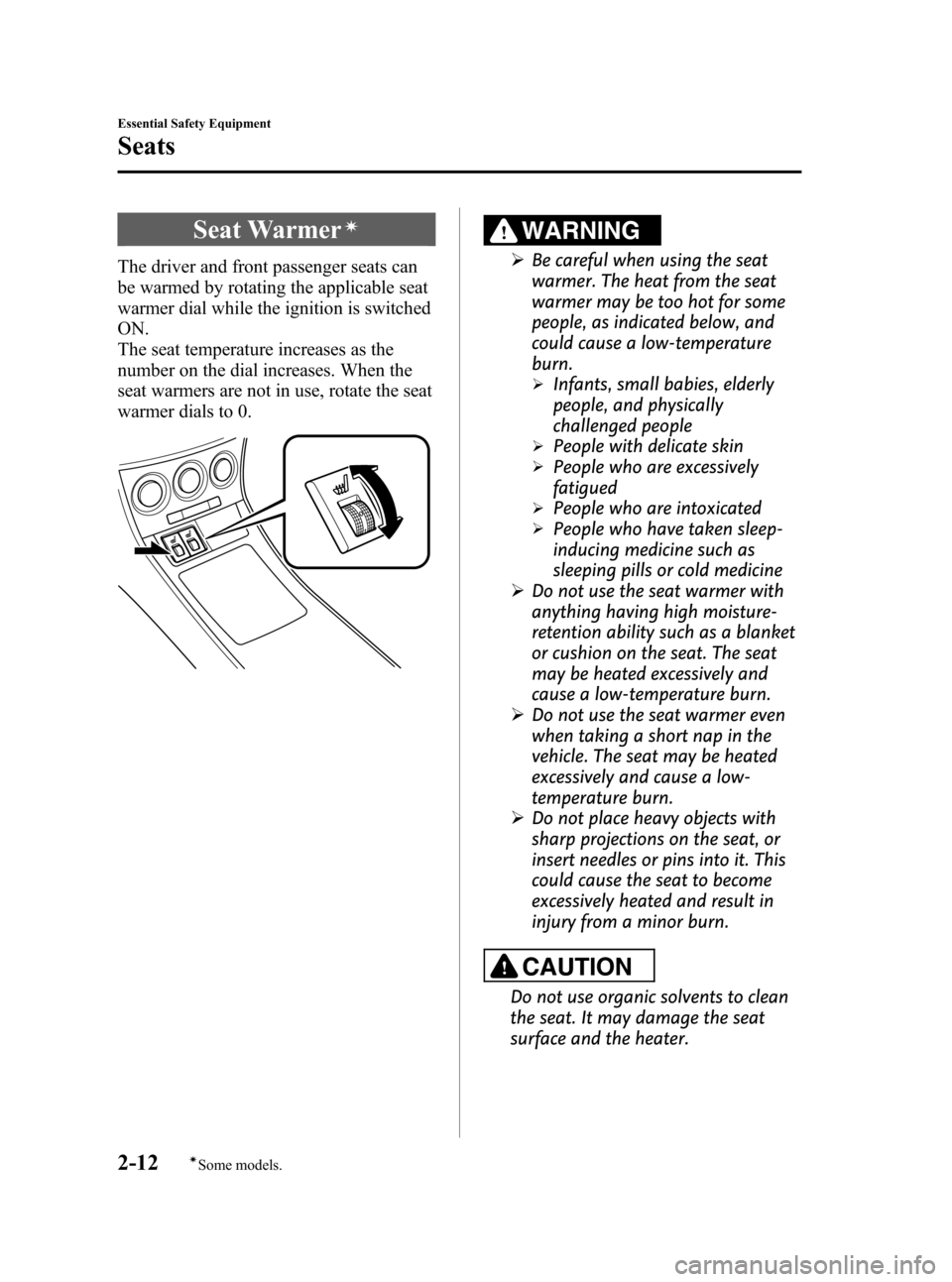
Black plate (26,1)
Seat Warmerí
The driver and front passenger seats can
be warmed by rotating the applicable seat
warmer dial while the ignition is switched
ON.
The seat temperature increases as the
number on the dial increases. When the
seat warmers are not in use, rotate the seat
warmer dials to 0.
WARNING
ØBe careful when using the seat
warmer. The heat from the seat
warmer may be too hot for some
people, as indicated below, and
could cause a low-temperature
burn.
ØInfants, small babies, elderly
people, and physically
challenged people
ØPeople with delicate skin
ØPeople who are excessively
fatigued
ØPeople who are intoxicated
ØPeople who have taken sleep-
inducing medicine such as
sleeping pills or cold medicine
Ø Do not use the seat warmer with
anything having high moisture-
retention ability such as a blanket
or cushion on the seat. The seat
may be heated excessively and
cause a low-temperature burn.
Ø Do not use the seat warmer even
when taking a short nap in the
vehicle. The seat may be heated
excessively and cause a low-
temperature burn.
Ø Do not place heavy objects with
sharp projections on the seat, or
insert needles or pins into it. This
could cause the seat to become
excessively heated and result in
injury from a minor burn.
CAUTION
Do not use organic solvents to clean
the seat. It may damage the seat
surface and the heater.
2-12
Essential Safety Equipment
íSome models.
Seats
Mazda3_8BY7-EC-11F_Edition1 Page26
Friday, June 17 2011 2:54 PM
Form No.8BY7-EC-11F
Page 29 of 525
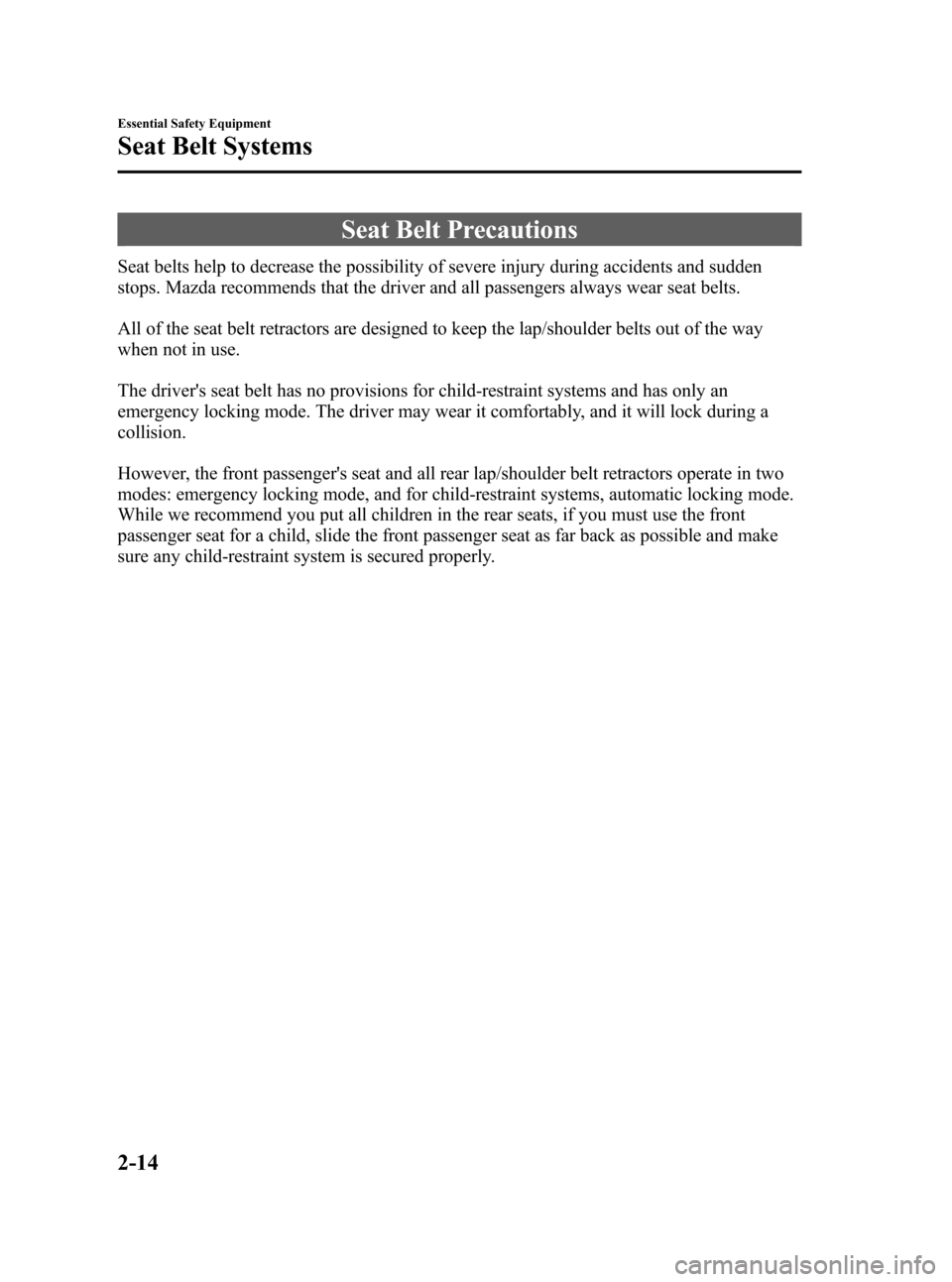
Black plate (28,1)
Seat Belt Precautions
Seat belts help to decrease the possibility of severe injury during accidents and sudden
stops. Mazda recommends that the driver and all passengers always wear seat belts.
All of the seat belt retractors are designed to keep the lap/shoulder belts out of the way
when not in use.
The driver's seat belt has no provisions for child-restraint systems and has only an
emergency locking mode. The driver may wear it comfortably, and it will lock during a
collision.
However, the front passenger's seat and all rear lap/shoulder belt retractors operate in two
modes: emergency locking mode, and for child-restraint systems, automatic locking mode.
While we recommend you put all children in the rear seats, if you must use the front
passenger seat for a child, slide the front passenger seat as far back as possible and make
sure any child-restraint system is secured properly.
2-14
Essential Safety Equipment
Seat Belt Systems
Mazda3_8BY7-EC-11F_Edition1 Page28
Friday, June 17 2011 2:54 PM
Form No.8BY7-EC-11F
Page 31 of 525

Black plate (30,1)
CAUTION
Belt retraction may become difficult if the belts and rings are soiled, so try to keep
them clean. For more details about cleaning the seat belts, refer to“Cleaning the
Lap/Shoulder Belt Webbing ”(page 8-71).
q Pregnant Women and Persons with Serious Medical Conditions
Pregnant women should always wear seat belts. Ask your doctor for specific
recommendations.
The lap belt should be worn SNUGLY AND AS LOW AS POSSIBLE OVER THE HIPS.
The shoulder belt should be worn across your shoulder properly, but never across the
stomach area.
Persons with serious medical conditions also should wear seat belts. Check with your
doctor for any special instructions regarding specific medical conditions.
qEmergency Locking Mode
In the emergency locking mode, the belt remains comfortable on the occupant and the
retractor will lock in position during a collision. When the seat belt is fastened, it will
always be in the emergency locking mode until it is switched to automatic locking mode by
pulling it all the way out to its full length. If the belt feels tight and hinders comfortable
movement while the vehicle is stopped or in motion, it may be in the automatic locking
mode because the belt has been pulled too far out. To return the belt to the more
comfortable emergency locking mode, wait until the vehicle has stopped in a safe, level
area, retract the belt fully to convert it back to emergency locking mode and then extend it
around you again.
If the belt is locked and cannot be pulled out, retract the belt once, and then try pulling it
out slowly. If this fails, pull the belt strongly one time and loosen, then pull it out again
slowly.
2-16
Essential Safety Equipment
Seat Belt Systems
Mazda3_8BY7-EC-11F_Edition1 Page30
Friday, June 17 2011 2:54 PM
Form No.8BY7-EC-11F
Page 35 of 525
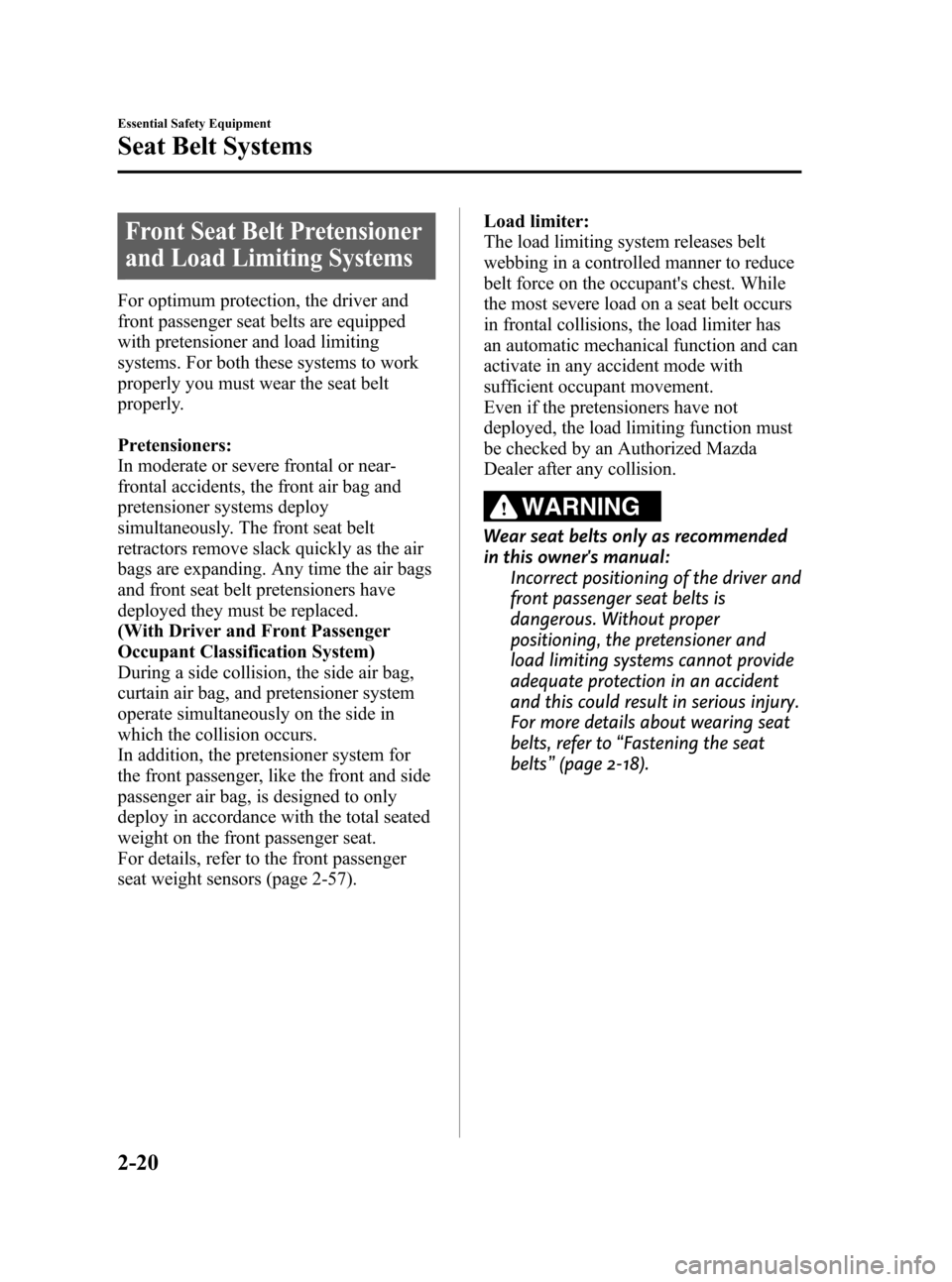
Black plate (34,1)
Front Seat Belt Pretensioner
and Load Limiting Systems
For optimum protection, the driver and
front passenger seat belts are equipped
with pretensioner and load limiting
systems. For both these systems to work
properly you must wear the seat belt
properly.
Pretensioners:
In moderate or severe frontal or near-
frontal accidents, the front air bag and
pretensioner systems deploy
simultaneously. The front seat belt
retractors remove slack quickly as the air
bags are expanding. Any time the air bags
and front seat belt pretensioners have
deployed they must be replaced.
(With Driver and Front Passenger
Occupant Classification System)
During a side collision, the side air bag,
curtain air bag, and pretensioner system
operate simultaneously on the side in
which the collision occurs.
In addition, the pretensioner system for
the front passenger, like the front and side
passenger air bag, is designed to only
deploy in accordance with the total seated
weight on the front passenger seat.
For details, refer to the front passenger
seat weight sensors (page 2-57).Load limiter:
The load limiting system releases belt
webbing in a controlled manner to reduce
belt force on the occupant's chest. While
the most severe load on a seat belt occurs
in frontal collisions, the load limiter has
an automatic mechanical function and can
activate in any accident mode with
sufficient occupant movement.
Even if the pretensioners have not
deployed, the load limiting function must
be checked by an Authorized Mazda
Dealer after any collision.
WARNING
Wear seat belts only as recommended
in this owner's manual:
Incorrect positioning of the driver and
front passenger seat belts is
dangerous. Without proper
positioning, the pretensioner and
load limiting systems cannot provide
adequate protection in an accident
and this could result in serious injury.
For more details about wearing seat
belts, refer to “Fastening the seat
belts ”(page 2-18).
2-20
Essential Safety Equipment
Seat Belt Systems
Mazda3_8BY7-EC-11F_Edition1 Page34
Friday, June 17 2011 2:54 PM
Form No.8BY7-EC-11F
Page 40 of 525
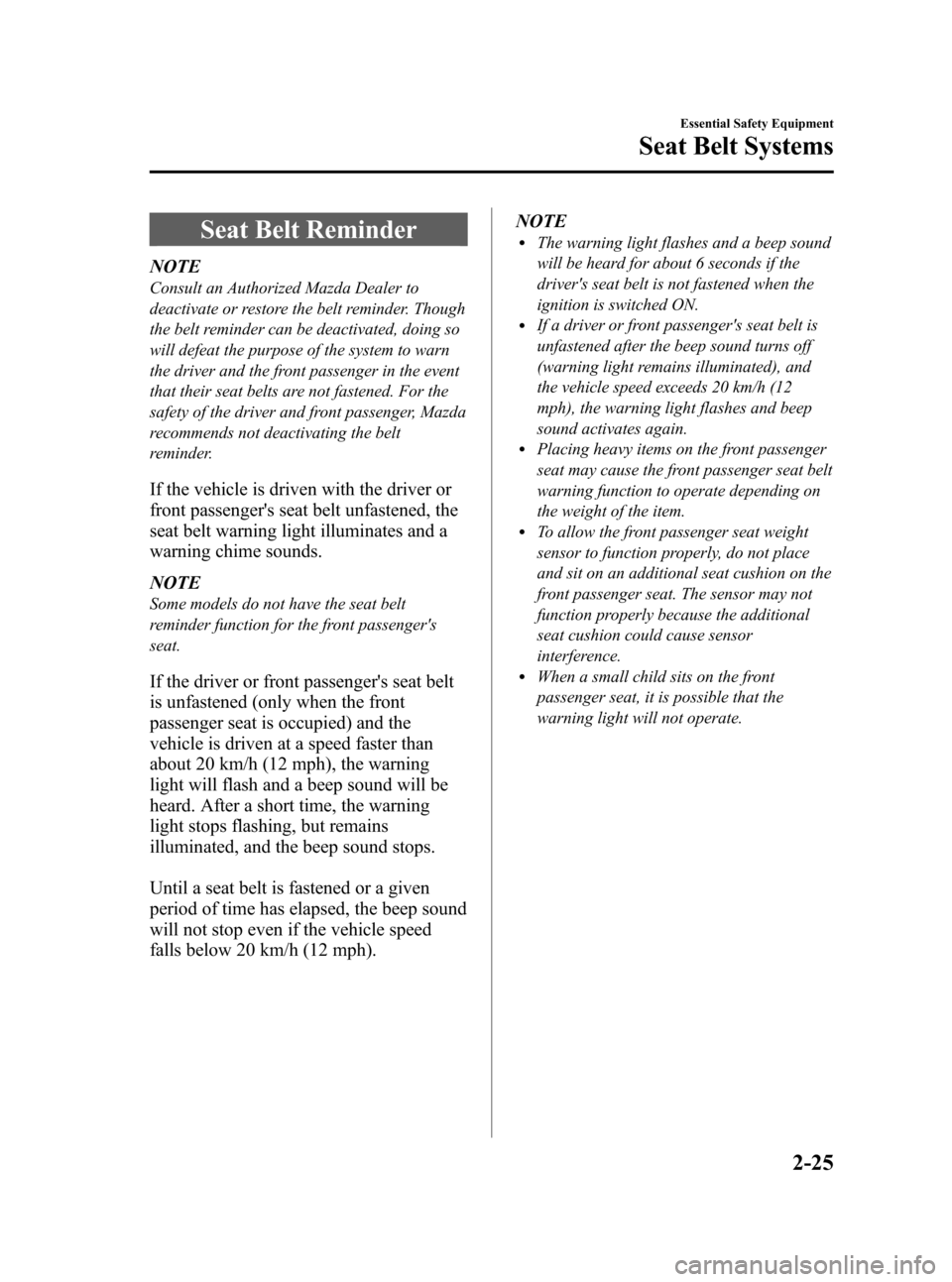
Black plate (39,1)
Seat Belt Reminder
NOTE
Consult an Authorized Mazda Dealer to
deactivate or restore the belt reminder. Though
the belt reminder can be deactivated, doing so
will defeat the purpose of the system to warn
the driver and the front passenger in the event
that their seat belts are not fastened. For the
safety of the driver and front passenger, Mazda
recommends not deactivating the belt
reminder.
If the vehicle is driven with the driver or
front passenger's seat belt unfastened, the
seat belt warning light illuminates and a
warning chime sounds.
NOTE
Some models do not have the seat belt
reminder function for the front passenger's
seat.
If the driver or front passenger's seat belt
is unfastened (only when the front
passenger seat is occupied) and the
vehicle is driven at a speed faster than
about 20 km/h (12 mph), the warning
light will flash and a beep sound will be
heard. After a short time, the warning
light stops flashing, but remains
illuminated, and the beep sound stops.
Until a seat belt is fastened or a given
period of time has elapsed, the beep sound
will not stop even if the vehicle speed
falls below 20 km/h (12 mph).NOTE
lThe warning light flashes and a beep sound
will be heard for about 6 seconds if the
driver's seat belt is not fastened when the
ignition is switched ON.
lIf a driver or front passenger's seat belt is
unfastened after the beep sound turns off
(warning light remains illuminated), and
the vehicle speed exceeds 20 km/h (12
mph), the warning light flashes and beep
sound activates again.
lPlacing heavy items on the front passenger
seat may cause the front passenger seat belt
warning function to operate depending on
the weight of the item.
lTo allow the front passenger seat weight
sensor to function properly, do not place
and sit on an additional seat cushion on the
front passenger seat. The sensor may not
function properly because the additional
seat cushion could cause sensor
interference.
lWhen a small child sits on the front
passenger seat, it is possible that the
warning light will not operate.
Essential Safety Equipment
Seat Belt Systems
2-25
Mazda3_8BY7-EC-11F_Edition1 Page39
Friday, June 17 2011 2:54 PM
Form No.8BY7-EC-11F
Page 47 of 525
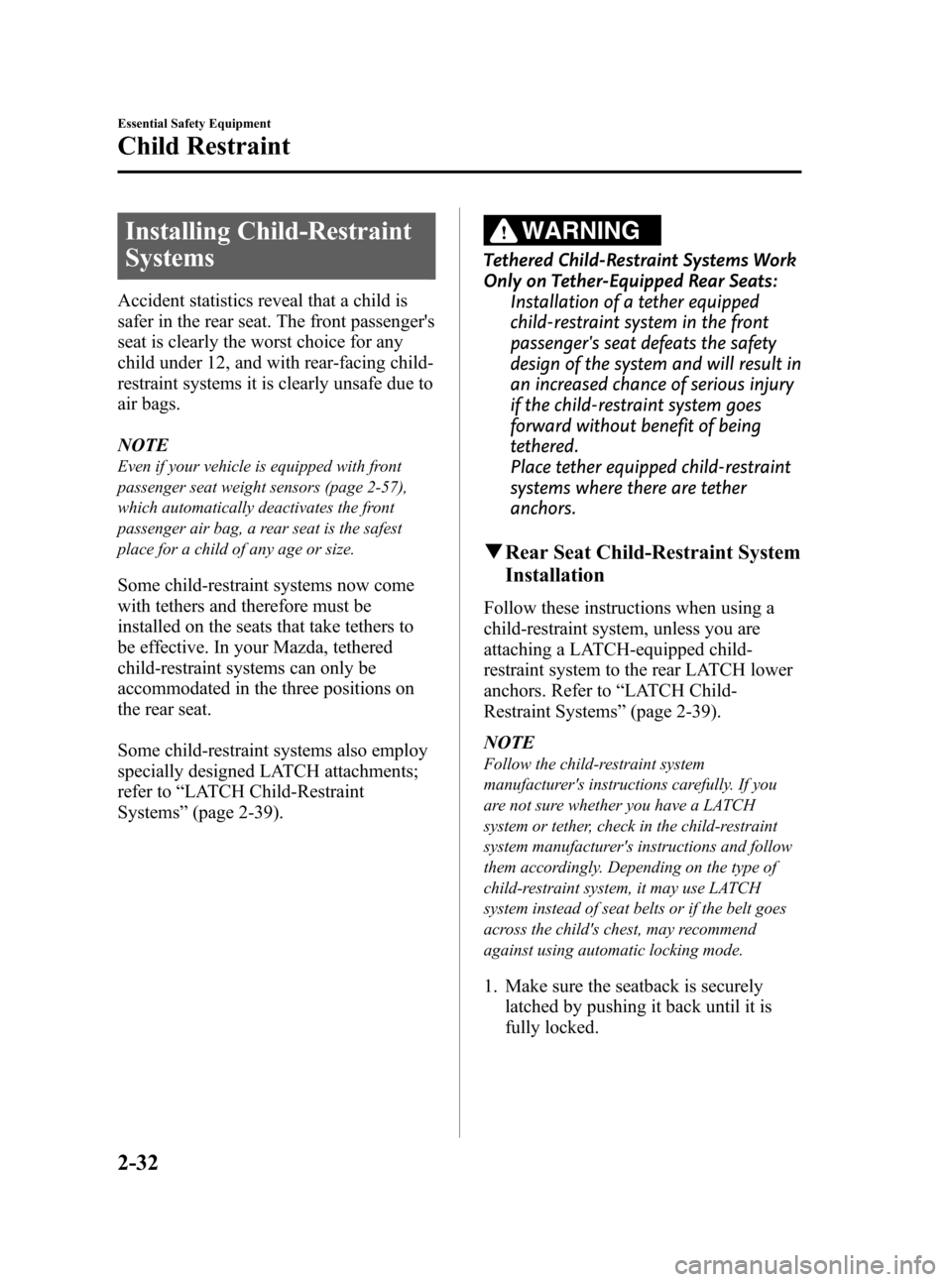
Black plate (46,1)
Installing Child-Restraint
Systems
Accident statistics reveal that a child is
safer in the rear seat. The front passenger's
seat is clearly the worst choice for any
child under 12, and with rear-facing child-
restraint systems it is clearly unsafe due to
air bags.
NOTE
Even if your vehicle is equipped with front
passenger seat weight sensors (page 2-57),
which automatically deactivates the front
passenger air bag, a rear seat is the safest
place for a child of any age or size.
Some child-restraint systems now come
with tethers and therefore must be
installed on the seats that take tethers to
be effective. In your Mazda, tethered
child-restraint systems can only be
accommodated in the three positions on
the rear seat.
Some child-restraint systems also employ
specially designed LATCH attachments;
refer to“LATCH Child-Restraint
Systems ”(page 2-39).
WARNING
Tethered Child-Restraint Systems Work
Only on Tether-Equipped Rear Seats:
Installation of a tether equipped
child-restraint system in the front
passenger's seat defeats the safety
design of the system and will result in
an increased chance of serious injury
if the child-restraint system goes
forward without benefit of being
tethered.
Place tether equipped child-restraint
systems where there are tether
anchors.
qRear Seat Child-Restraint System
Installation
Follow these instructions when using a
child-restraint system, unless you are
attaching a LATCH-equipped child-
restraint system to the rear LATCH lower
anchors. Refer to “LATCH Child-
Restraint Systems ”(page 2-39).
NOTE
Follow the child-restraint system
manufacturer's instructions carefully. If you
are not sure whether you have a LATCH
system or tether, check in the child-restraint
system manufacturer's instructions and follow
them accordingly. Depending on the type of
child-restraint system, it may use LATCH
system instead of seat belts or if the belt goes
across the child's chest, may recommend
against using automatic locking mode.
1. Make sure the seatback is securely latched by pushing it back until it is
fully locked.
2-32
Essential Safety Equipment
Child Restraint
Mazda3_8BY7-EC-11F_Edition1 Page46
Friday, June 17 2011 2:54 PM
Form No.8BY7-EC-11F
Page 105 of 525
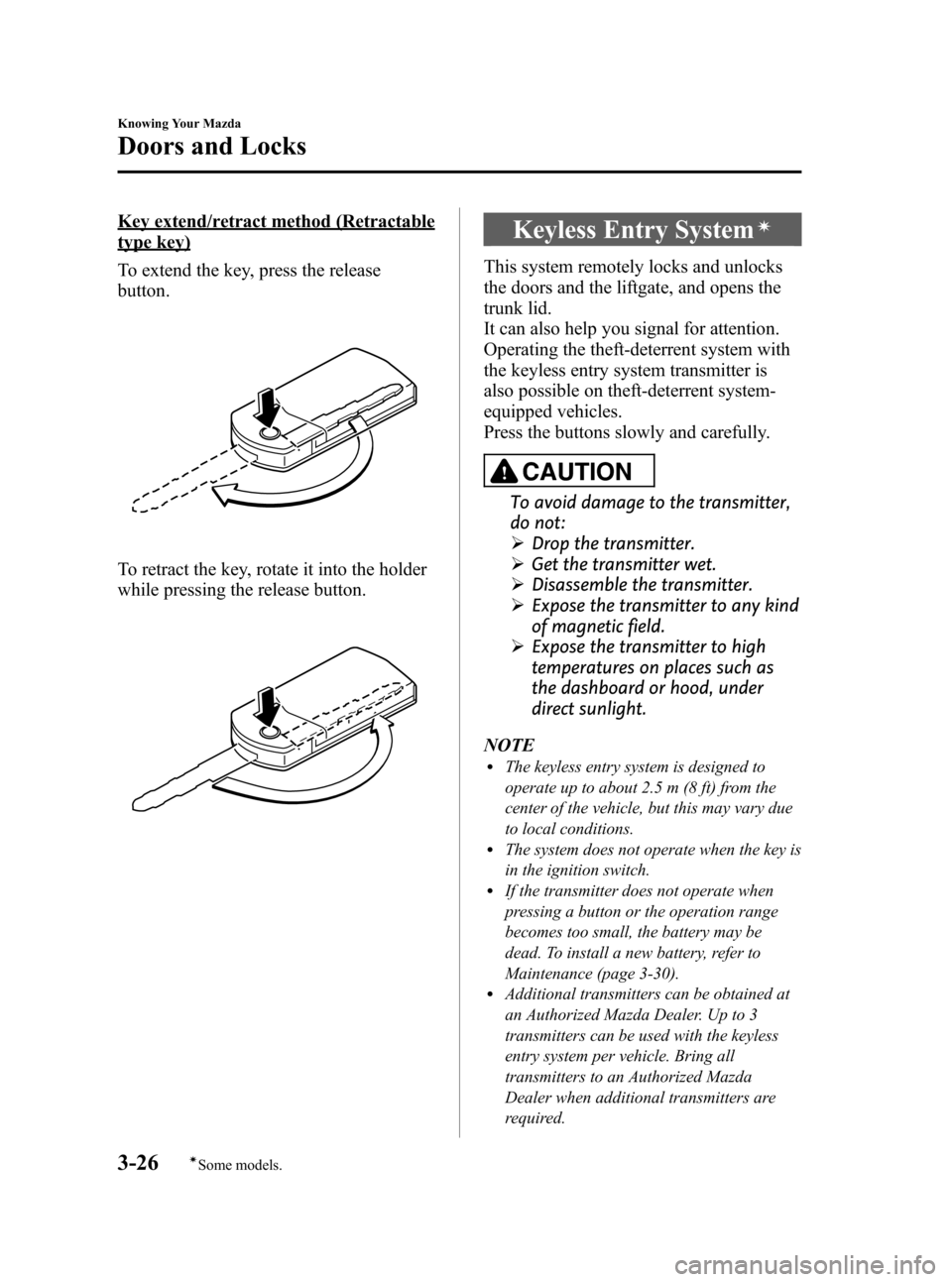
Black plate (104,1)
Key extend/retract method (Retractable
type key)
To extend the key, press the release
button.
To retract the key, rotate it into the holder
while pressing the release button.
Keyless Entry Systemí
This system remotely locks and unlocks
the doors and the liftgate, and opens the
trunk lid.
It can also help you signal for attention.
Operating the theft-deterrent system with
the keyless entry system transmitter is
also possible on theft-deterrent system-
equipped vehicles.
Press the buttons slowly and carefully.
CAUTION
To avoid damage to the transmitter,
do not:
ØDrop the transmitter.
Ø Get the transmitter wet.
Ø Disassemble the transmitter.
Ø Expose the transmitter to any kind
of magnetic field.
Ø Expose the transmitter to high
temperatures on places such as
the dashboard or hood, under
direct sunlight.
NOTE
lThe keyless entry system is designed to
operate up to about 2.5 m (8 ft) from the
center of the vehicle, but this may vary due
to local conditions.
lThe system does not operate when the key is
in the ignition switch.
lIf the transmitter does not operate when
pressing a button or the operation range
becomes too small, the battery may be
dead. To install a new battery, refer to
Maintenance (page 3-30).
lAdditional transmitters can be obtained at
an Authorized Mazda Dealer. Up to 3
transmitters can be used with the keyless
entry system per vehicle. Bring all
transmitters to an Authorized Mazda
Dealer when additional transmitters are
required.
3-26
Knowing Your Mazda
íSome models.
Doors and Locks
Mazda3_8BY7-EC-11F_Edition1 Page104
Friday, June 17 2011 2:54 PM
Form No.8BY7-EC-11F
Page 141 of 525
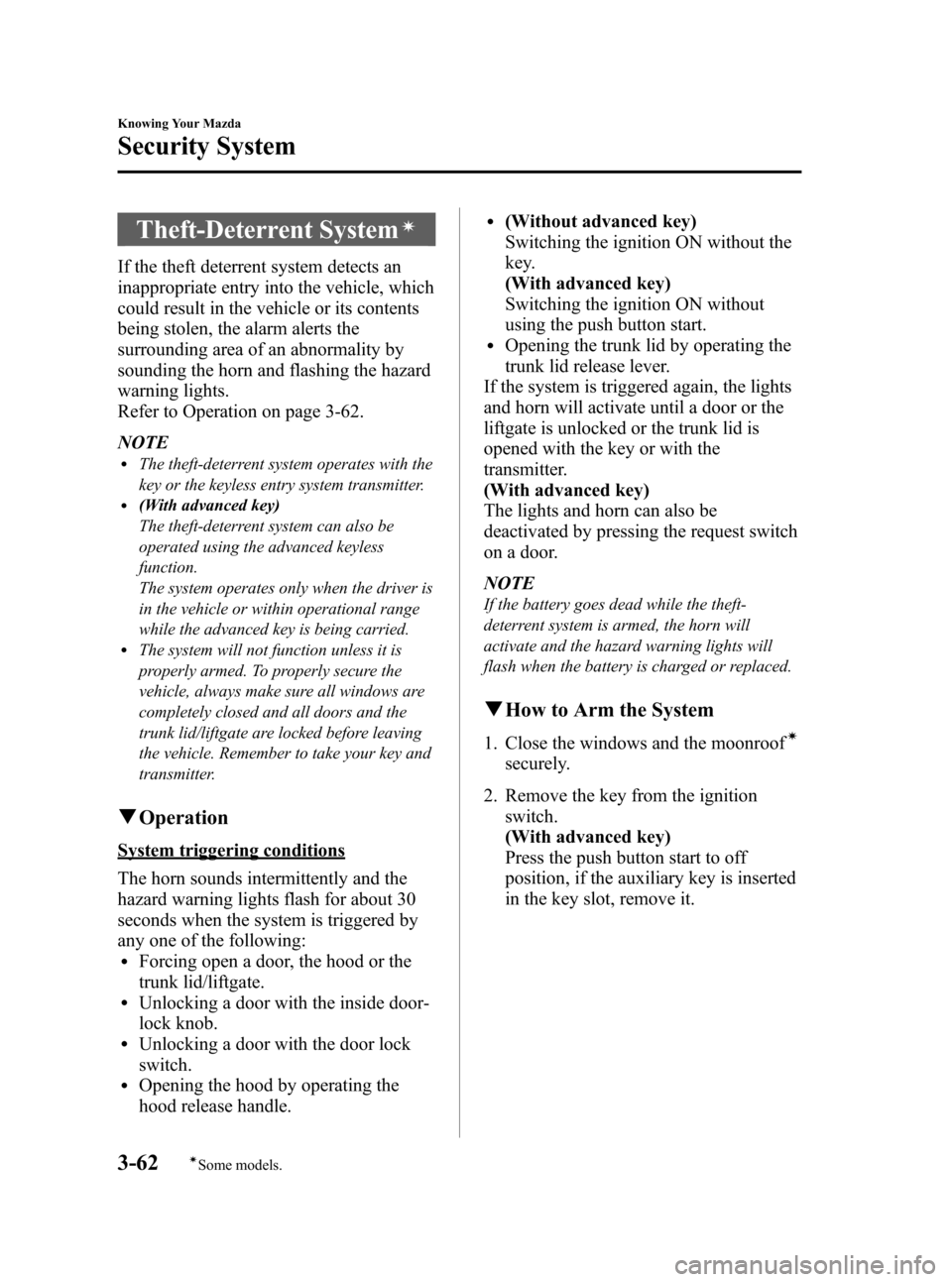
Black plate (140,1)
Theft-Deterrent Systemí
If the theft deterrent system detects an
inappropriate entry into the vehicle, which
could result in the vehicle or its contents
being stolen, the alarm alerts the
surrounding area of an abnormality by
sounding the horn and flashing the hazard
warning lights.
Refer to Operation on page 3-62.
NOTE
lThe theft-deterrent system operates with the
key or the keyless entry system transmitter.
l(With advanced key)
The theft-deterrent system can also be
operated using the advanced keyless
function.
The system operates only when the driver is
in the vehicle or within operational range
while the advanced key is being carried.
lThe system will not function unless it is
properly armed. To properly secure the
vehicle, always make sure all windows are
completely closed and all doors and the
trunk lid/liftgate are locked before leaving
the vehicle. Remember to take your key and
transmitter.
qOperation
System triggering conditions
The horn sounds intermittently and the
hazard warning lights flash for about 30
seconds when the system is triggered by
any one of the following:
lForcing open a door, the hood or the
trunk lid/liftgate.
lUnlocking a door with the inside door-
lock knob.
lUnlocking a door with the door lock
switch.
lOpening the hood by operating the
hood release handle.
l(Without advanced key)
Switching the ignition ON without the
key.
(With advanced key)
Switching the ignition ON without
using the push button start.
lOpening the trunk lid by operating the
trunk lid release lever.
If the system is triggered again, the lights
and horn will activate until a door or the
liftgate is unlocked or the trunk lid is
opened with the key or with the
transmitter.
(With advanced key)
The lights and horn can also be
deactivated by pressing the request switch
on a door.
NOTE
If the battery goes dead while the theft-
deterrent system is armed, the horn will
activate and the hazard warning lights will
flash when the battery is charged or replaced.
q How to Arm the System
1. Close the windows and the moonroofí
securely.
2. Remove the key from the ignition switch.
(With advanced key)
Press the push button start to off
position, if the auxiliary key is inserted
in the key slot, remove it.
3-62
Knowing Your Mazda
íSome models.
Security System
Mazda3_8BY7-EC-11F_Edition1 Page140
Friday, June 17 2011 2:55 PM
Form No.8BY7-EC-11F
Page 142 of 525
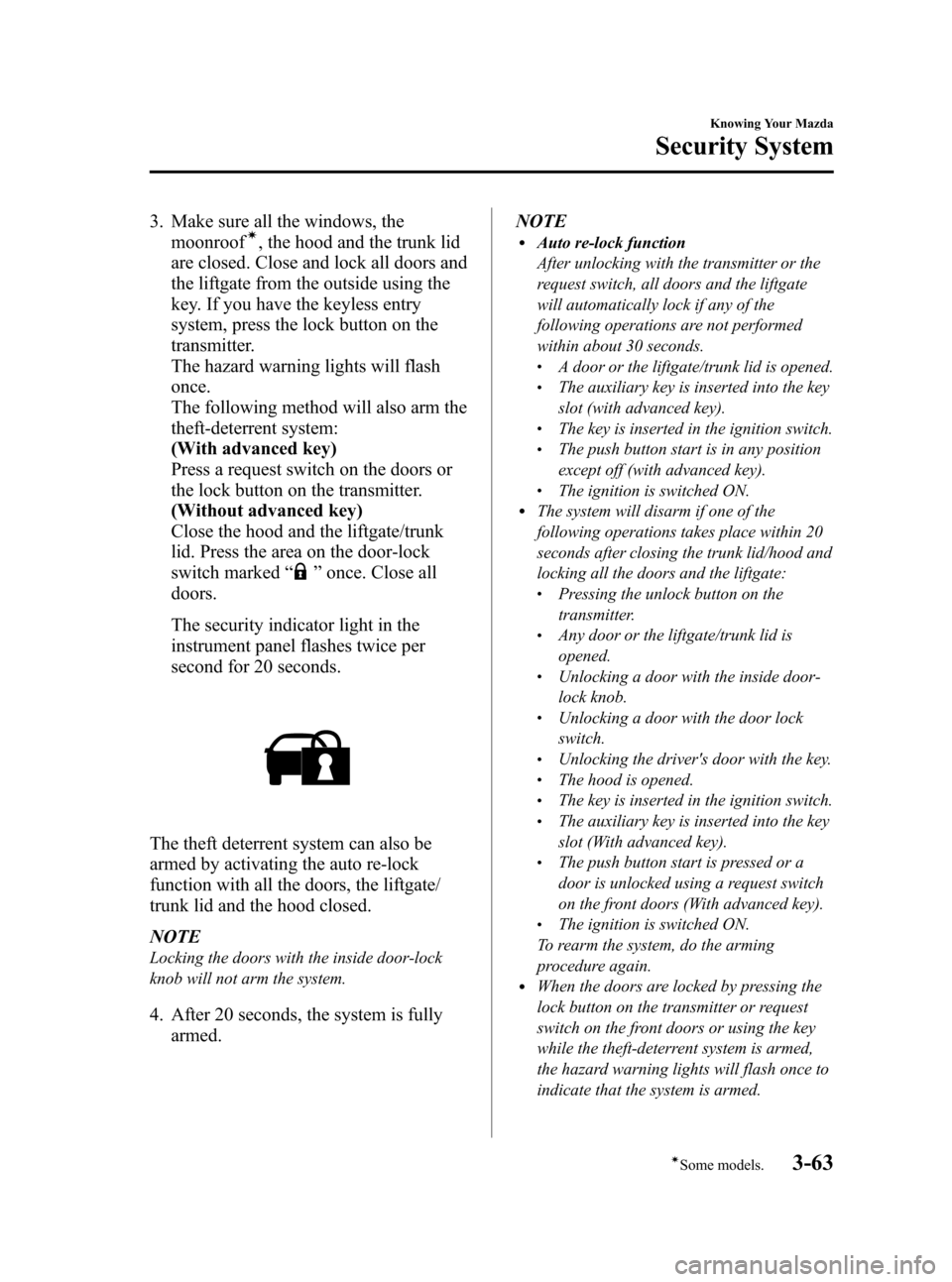
Black plate (141,1)
3. Make sure all the windows, themoonroofí, the hood and the trunk lid
are closed. Close and lock all doors and
the liftgate from the outside using the
key. If you have the keyless entry
system, press the lock button on the
transmitter.
The hazard warning lights will flash
once.
The following method will also arm the
theft-deterrent system:
(With advanced key)
Press a request switch on the doors or
the lock button on the transmitter.
(Without advanced key)
Close the hood and the liftgate/trunk
lid. Press the area on the door-lock
switch marked “
”once. Close all
doors.
The security indicator light in the
instrument panel flashes twice per
second for 20 seconds.
The theft deterrent system can also be
armed by activating the auto re-lock
function with all the doors, the liftgate/
trunk lid and the hood closed.
NOTE
Locking the doors with the inside door-lock
knob will not arm the system.
4. After 20 seconds, the system is fully armed. NOTE
lAuto re-lock function
After unlocking with the transmitter or the
request switch, all doors and the liftgate
will automatically lock if any of the
following operations are not performed
within about 30 seconds.
lA door or the liftgate/trunk lid is opened.lThe auxiliary key is inserted into the key
slot (with advanced key).
lThe key is inserted in the ignition switch.lThe push button start is in any position
except off (with advanced key).
lThe ignition is switched ON.lThe system will disarm if one of the
following operations takes place within 20
seconds after closing the trunk lid/hood and
locking all the doors and the liftgate:
lPressing the unlock button on the
transmitter.
lAny door or the liftgate/trunk lid is
opened.
lUnlocking a door with the inside door-
lock knob.
lUnlocking a door with the door lock
switch.
lUnlocking the driver's door with the key.lThe hood is opened.lThe key is inserted in the ignition switch.lThe auxiliary key is inserted into the key
slot (With advanced key).
lThe push button start is pressed or a
door is unlocked using a request switch
on the front doors (With advanced key).
lThe ignition is switched ON.
To rearm the system, do the arming
procedure again.
lWhen the doors are locked by pressing the
lock button on the transmitter or request
switch on the front doors or using the key
while the theft-deterrent system is armed,
the hazard warning lights will flash once to
indicate that the system is armed.
Knowing Your Mazda
Security System
3-63íSome models.
Mazda3_8BY7-EC-11F_Edition1 Page141
Friday, June 17 2011 2:55 PM
Form No.8BY7-EC-11F